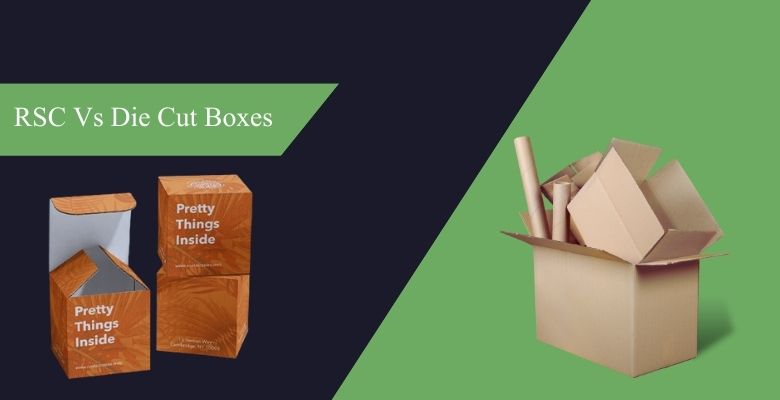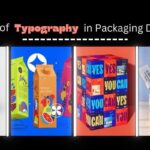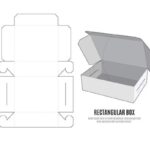Packaging plays a vital role in any business, especially those that deal with shipping products directly to customers. Choosing the right type of box for shipping is crucial, as it impacts cost, presentation, and durability. Two common packaging options are Regular Slotted Containers (RSC) and Die Cut Boxes. Each has unique benefits and is suited for different types of shipping needs, products, and branding requirements. This guide will dive into the differences between RSC and die cut boxes, covering aspects such as cost, customization, eco-friendliness, and more to help you make the best choice for your business.
What are Regular Slotted Containers (RSC)?
Regular Slotted Containers (RSC) are one of the most commonly used types of cardboard boxes. They are constructed from a single sheet of corrugated cardboard, with flaps that meet at the center when closed. RSC boxes are popular in many industries because of their straightforward design, ease of assembly, and affordability. These boxes are generally secured with tape, making them a simple yet effective option for packaging.
Key Characteristics of RSC Boxes:
- Affordability: RSC boxes are usually more cost-effective because they require minimal cardboard and don’t need specialized tooling.
- Ease of Use: Their simple structure makes them quick and easy to assemble, which can be helpful for businesses dealing with high volumes of orders.
- Eco-Friendliness: RSC boxes are recyclable and can be made from recycled or eco-friendly materials.
- Versatility: They work well for shipping various types of products and are available in a range of sizes.
What are Die Cut Boxes?
Die cut boxes are custom boxes created using a die-cutting process. This process allows for precise cuts and custom shapes, enabling companies to create boxes that fit specific product dimensions perfectly. Die cut boxes are often used in industries where presentation and product fit are essential, such as cosmetics, electronics, and luxury goods. These boxes can also be designed with unique features, such as custom flaps, windows, or compartments, to enhance the unboxing experience.
Key Characteristics of Die Cut Boxes:
- Customization: Die cut boxes can be tailored to fit products exactly, providing a secure fit that reduces the need for additional padding.
- Aesthetic Appeal: Custom shapes and designs make die cut boxes ideal for brands aiming for a premium look.
- Enhanced Protection: The custom fit reduces movement inside the box, which can be beneficial for fragile or high-value items.
- Branding Potential: Die cut boxes offer more flexibility in design, making it easier to incorporate complex logos, patterns, or colors that align with the brand.
Comparing RSC and Die Cut Boxes: Key Factors
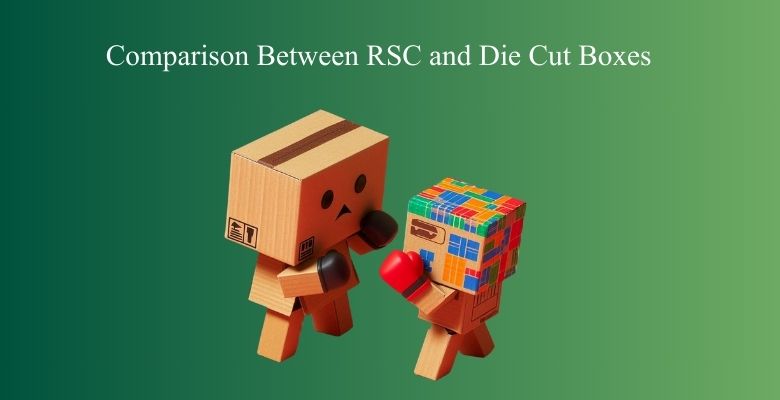
Both RSC and die cut boxes have distinct advantages depending on the needs of the business. Here’s a detailed comparison of these two packaging options based on essential factors.
1. Cost
One of the most significant differences between RSC and die cut boxes is cost.
- RSC Boxes: Typically more affordable, RSC boxes use less material and don’t require specialized tooling for production. This makes them an economical choice for businesses with large shipping volumes or limited budgets. However, they may require additional packaging materials, such as tape or filler, which can add to the overall cost.
- Die Cut Boxes: Due to the custom cutting process, die cut boxes tend to be more expensive. The cost of producing a die (the mold used for cutting) and the more intricate designs often make them pricier than RSC boxes. However, because die cut boxes offer a snug fit, they may reduce the need for additional packing materials, which can offset some costs.
In summary, RSC boxes are generally the more budget-friendly option, especially for large orders, while die cut boxes may be more cost-effective in situations where branding and product fit are priorities.
2. Ease of Use
Assembly is another factor to consider when choosing between RSC and die cut boxes.
- RSC Boxes: These boxes are simple to assemble, as they only require folding and taping the flaps. This ease of use makes them ideal for businesses with high packing volumes or those who need a straightforward packaging solution.
- Die Cut Boxes: The assembly of die cut boxes can vary depending on the design. While some die cut boxes are easy to fold, others with complex shapes may take additional time to assemble. This could impact packing efficiency, especially for companies with high shipping volumes.
Overall, RSC boxes are easier and faster to assemble, making them suitable for businesses prioritizing speed and simplicity in packaging.
3. Customization
Customization is crucial for brands looking to create a unique or premium packaging experience.
- RSC Boxes: Although RSC boxes can be branded with logos or simple designs, their structure is typically more basic. They’re ideal for straightforward branding with one or two colors but may not offer the same level of customization as die cut boxes.
- Die Cut Boxes: Die cut boxes are highly customizable and can be designed to fit the exact dimensions of the product. They offer more freedom in terms of shape, design, and structure, making them ideal for businesses wanting to create a memorable unboxing experience.
In short, die cut boxes are superior for customization and allow for more creative packaging solutions that can enhance brand perception.
4. Eco-Friendliness
As consumers become increasingly environmentally conscious, the eco-friendliness of packaging materials is a growing concern.
- RSC Boxes: These boxes are typically recyclable and can be made from recycled materials, making them an eco-friendly choice. They are also simple to disassemble, making them easy for consumers to recycle.
- Die Cut Boxes: Like RSC boxes, die cut boxes can be made from recyclable materials, and their custom fit may reduce the need for additional packaging fillers, further reducing environmental impact.
Both options can be eco-friendly, but RSC boxes may offer a slight edge due to their simplicity and minimal material requirements.
5. Flexibility
Flexibility in packaging can be essential when dealing with various types of products and shipping requirements.
- RSC Boxes: Due to their basic structure, RSC boxes are versatile and can accommodate multiple items in a single shipment. This makes them a good choice for businesses shipping mixed product orders or larger, less fragile items.
- Die Cut Boxes: Die cut boxes are less flexible in terms of size and structure as they’re typically designed to fit a specific product. While they excel at protecting individual items, they may not be ideal for shipping multiple items together.
For businesses that need to ship multiple items together, RSC boxes provide more flexibility.
Read Also: Small Business Shipping Options and Best Practices: The Ultimate Guide
6. Brand Perception
Packaging is an extension of a brand, and it plays a significant role in shaping the customer’s first impression.
- RSC Boxes: These boxes are functional and sturdy but may not convey a high-end look. They are best suited for brands where simplicity and practicality are valued over luxury.
- Die Cut Boxes: Known for their premium look, die cut boxes are often the standard in industries that require elegant packaging. They allow for intricate designs and finishes, which can elevate a brand’s image and create a memorable unboxing experience.
Die cut boxes are generally preferred for premium brands and can enhance brand perception, especially in industries where presentation is key.
Choosing Between RSC and Die Cut Boxes
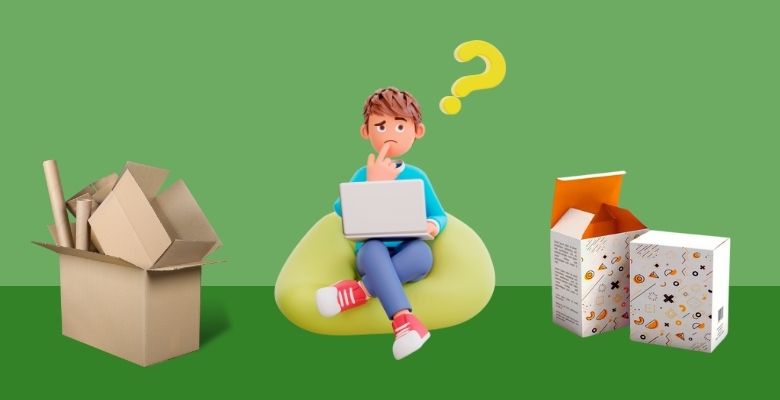
Selecting the right packaging option depends on a combination of factors unique to each business. Here’s a checklist to help you decide:
- Product Type: Consider what you’re shipping. Fragile, high-value, or odd-shaped items may benefit from die cut boxes, while sturdy, bulkier items can be safely shipped in RSC boxes.
- Shipping Method: Longer or rougher shipping routes may require sturdier packaging or additional padding, influencing your choice.
- Branding Requirements: If branding is crucial, die cut boxes offer more options for creativity, while RSC boxes are better for simpler designs.
- Volume and Frequency: For high-volume shipments, RSC boxes may be more cost-effective and easier to assemble.
- Environmental Concerns: Both box types can be eco-friendly, but RSC boxes generally use less material and are easy to recycle.
Common Uses for RSC and Die Cut Boxes
Each type of box serves well in different industries:
- RSC Boxes: Common in e-commerce, warehousing, and food industries for bulk shipping of products that don’t require custom sizing.
- Die Cut Boxes: Often used in cosmetics, electronics, and high-end retail where brand presentation is critical, and items benefit from a custom fit.
Read Also: Ultimate Guide to Different USPS Box Options
FAQs on RSC and Die Cut Boxes
- Are RSC boxes cheaper than die cut boxes?
Yes, RSC boxes are typically more affordable due to their simpler construction and minimal material usage. - Can die cut boxes be made eco-friendly?
Absolutely. Die cut boxes can be manufactured from recycled and recyclable materials, and their custom fit may reduce the need for excess fillers. - Which is better for branding, RSC or die cut boxes?
Die cut boxes are better for intricate branding and designs, providing a high-end look that enhances the unboxing experience. - Can I use RSC boxes for fragile items?
Yes, but additional padding or fillers may be needed to ensure the product’s safety during transit.
Conclusion
Both Regular Slotted Containers (RSC) and Die Cut Boxes have their place in the packaging industry, each offering distinct advantages depending on the needs of your business. RSC boxes are cost-effective, versatile, and eco-friendly, making them an excellent choice for a wide range of applications, from shipping to storage.
